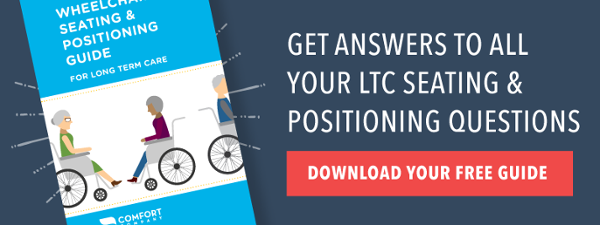We often get referrals for nursing home residents who are sitting poorly in their chairs. At first glance, we see a person all hunched over in the chair, with his legs falling off the leg rests, sliding forward, and with a windswept deformity. Our first thought often times is…How am I going to get him straight in that chair, with his legs even on those footrests, sitting erect in midline? Sound all too familiar? Don’t be ashamed to admit it.
Well, take a step back and think of yourself. Again, how many of us sit perfectly straight up all day with our legs evenly separated, at the same height, with our backs completely erect for twelve hours per day? Or thirty minutes for that matter?
NONE OF US!!!
So why demand that unrealistic perfect posture from our patients who most likely have a skeletal change that cannot be corrected? We have to realize that asymmetry can be a good thing when it comes to wheelchair positioning.
I encourage you to think outside the box and realize:
-
I don’t have to change it by fixing it; accommodation is just as good
-
I need to envelop and immerse that posture to decrease pressure and alleviate pain, add comfort, and enable the resident to sit as long as she needs
Sometimes one hip is contracted in flexion and the cushion needs to be raised higher on that side…Find a custom cushion that isn’t even.
Sometimes hamstrings are tighter on one side… Do it, make those leg rests heights and lengths uneven to accommodate for that shortening. THAT IS OK!!!
Sometimes a shoulder is subluxed and you need to raise or lower that arm rest…Go right ahead!
Sometimes the resident’s back is so kyphotic, sitting upright against a flat back is impossible…So replace the back support with a tension adjustable back that envelops and immerses the curvature. The resident will thank you for it!
So what if the sitting posture is not symmetrical and perfectly upright. BUT you have provided the correct seating system that will optimize resident function within the parameters of his/her limitations!
I urge you to break out of the old school mentality that “perfect” has to be completely upright and even. The number of residents who come back to you shortly after discharge with continued seating issues will significantly reduce. Good luck and happy positioning!
Next week we will begin the discussion on the difference between correcting an abnormal posture and accommodating for it. See you then!

Ana Endsjo, MOTR/L, CLT
Clinical Education Manager LTC Division
Ana Endsjo has worked as an occupational therapist since 2001 in a variety of treatment settings. She has mainly worked with the geriatric population, dedicated to the betterment of the treatment of the elderly in LTC centers. Her focus has been on seating and positioning and contracture management of the nursing home resident. With this experience, her hope is to guide other therapists, rehab directors, nurses, and administrators through educational guides, blogs, webinars, and live courses in her role as Clinical Education Manager for the long term care division.

